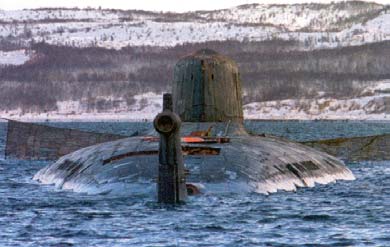In completing its task, the Nuclear Coordinating Group adopted the following principles to ensure that the preparatory and recovery operations would not present an unacceptable nuclear or radiation risk to those involved with the recovery and, generally, to the marine environment (NCG 2001):
• Limits and Conditions: A clear set of limits and conditions had to be established for all of the operations to ensure that credible hazards would not challenge the capability of the structures, systems and components involved, both on the
• Degradation and Recovery Operations: The limits and conditions safeguarding the structures, systems and its components would have to account for damage sustained during the sinking, the degradation over the year on the sea bed, and for forces and circumstances introduced by the Mammoet-Smit recovery operations.
• Defense in Depth: There should be a number of separate safeguards in place at all times against all of the significant hazards.
• Tried & Tested Technology: Since the deployment of novel procedures and processes introduces additional risk, preferably tried and tested technology should applied.
• ALARP: the risk should be reduced to As Low As is Reasonably Practical.
• Radiological Management Regime: Radiation doses to those personnel involved in the recovery operation should be controlled below the limits for Class B radiation workers (as defined for the UK).
• In Contingency: Contingency plans should exist in the unlikely event of a significant radiological release, particularly for mitigating the impact upon the marine environment.
Mammoet-Smit had contracted to raise the
A SUCCESSFUL RECOVERY
The recovery of the

In planning and carrying through the entire recovery operation, the Dutch consortium Mammoet-Smit engaged quite remarkable levels of ingenuity of approach to this unique problem. Their strategy of building on their experience of their equipment and of salvage operations in general proved to be sound and ultimately successful.
Because there was insufficient time to generate and evaluate a conventional postincident nuclear safety case, members of the Nuclear Coordinating Group had to arrive at judgments drawn from their experience in nuclear safety, weaponry and engineering. Moreover, in doing so they had to cross the divide between East and West, accounting not just for the different approaches to nuclear and engineering technologies, but also how the safety reasoning of the original designs could be integrated into the salvage scheme.
This demanding and unique approach was shown to be sound because there was no radiological release or significant radiation hazard to any of the M-S personnel or contactors during any part of the recovery operations.
REFERENCES AND NOTES
AMUNDSEN Ingar, et al,
NUCLEAR COODINATING GROUP, 1st, 2nd and 3rd Stage Reports of the Nuclear Coordinating Group, Report Ref № R3065-1B/C/D, throughout 2001
PRINZ C. A.,

